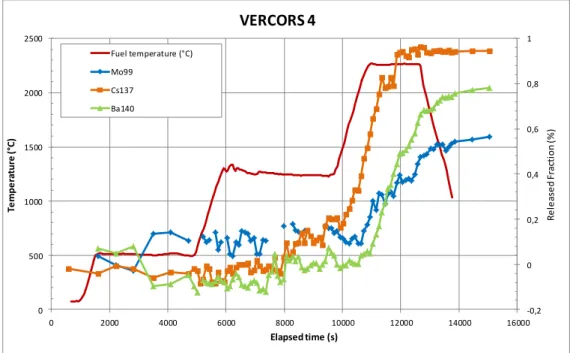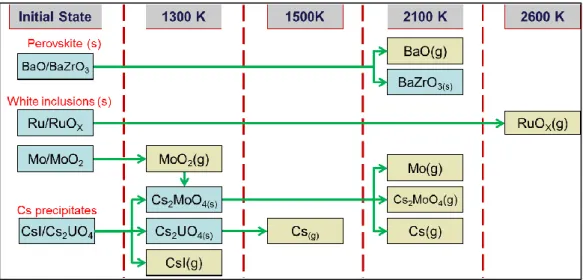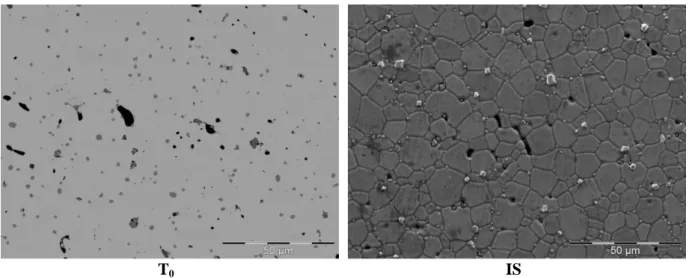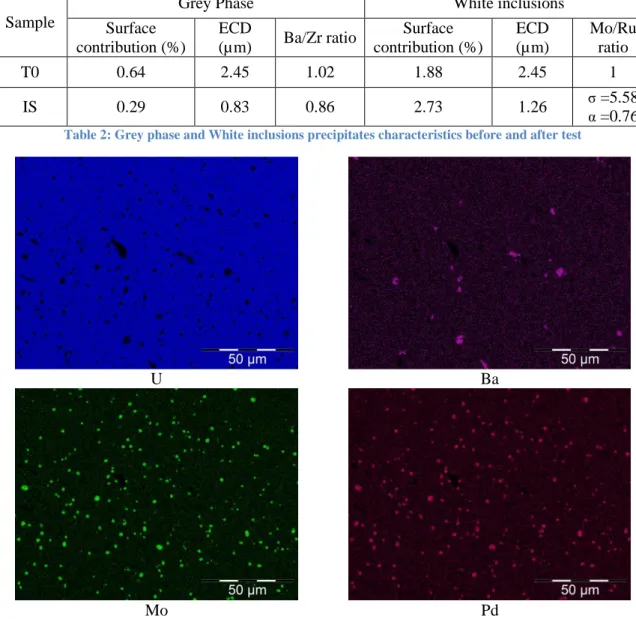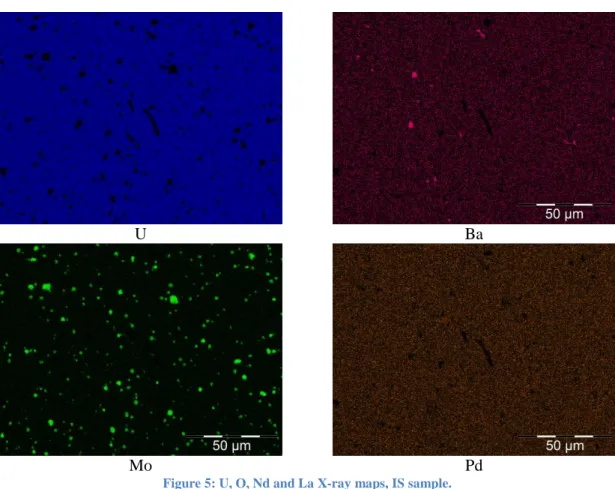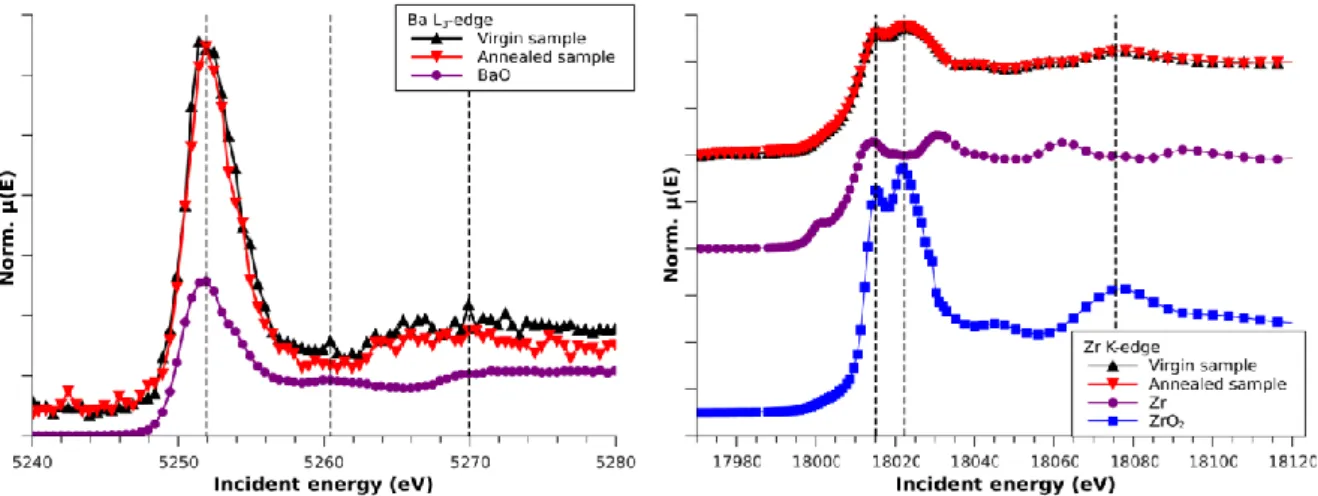HAL Id: cea-02509278
https://hal-cea.archives-ouvertes.fr/cea-02509278
Submitted on 16 Mar 2020HAL is a multi-disciplinary open access archive for the deposit and dissemination of sci-entific research documents, whether they are pub-lished or not. The documents may come from teaching and research institutions in France or abroad, or from public or private research centers.
L’archive ouverte pluridisciplinaire HAL, est destinée au dépôt et à la diffusion de documents scientifiques de niveau recherche, publiés ou non, émanant des établissements d’enseignement et de recherche français ou étrangers, des laboratoires publics ou privés.
E. Geiger, R. Bes, Yves Pontillon, P. Martin, G. Ducros
To cite this version:
E. Geiger, R. Bes, Yves Pontillon, P. Martin, G. Ducros. Use of model materials for fission products release study in Severe Accident Conditions. ERMSAR 2015 - 7th European Review Meeting on Severe Accident Research, Mar 2015, Marseille, France. �cea-02509278�
The 7th European Review Meeting on Severe Accident Research (ERMSAR-2015) Marseille, France, 24-26 March 2015
Use of Model Materials for Fission Products release study in
Severe Accident conditions
E. Geiger1; R. Bès2 ; Y. Pontillon1; P. Martin2 ; G. Ducros1
1: CEA, DEN, DEC, SA3C, 13108 Saint-Paul-Lez-Durance, France
2: CEA, DEN, DEC, SESC, 13108 Saint-Paul-Lez-Durance, France
Abstract:
Many integral and analytical research programs, such as PHEBUS FP, HI/VI, VEGA, VERCORS, etc., have been carried out aiming to understand the behaviour of fission products during a Nuclear Severe Accident. Most of them used standard PWR or BWR nuclear fuels with burn-ups going from traces up to about 70-80 GWd/t, which implied sophisticated experiments. Another way to study these matters is to use Model Materials doped with stable Fission Products in concentrations representative of a given burn-up, known as SIMFUEL. In order to demonstrate that they are an efficient alternative to irradiated fuel in the SA study, SIMFUEL samples doped with up to 12 Fission Products were submitted to annealing treatments in conditions representative of severe accidents. Samples were characterised before and after the tests by SEM-EDX and XAS, at SOLEIL and ESRF Synchrotrons, which are yet unavailable for irradiated fuels. Despite the limitations of SIMFUELS, it was found that the overall behaviour of fission products was similar to that observed for irradiated fuels and also consistent with thermodynamic estimations: the common chemical phases other than the fuel matrix were reproduced as well as the general fission products behaviour, in terms of release from the sample.
1. Introduction:
Severe accidents in nuclear power plants may involve the release of radioactive elements such as Fission Products (FP) into the atmosphere. Such was the case of the three major nuclear severe accidents in history: Three Mile Island in 1979, Chernobyl in 1986 and more recently Fukushima Dai-Ichi in 2011. The releases during the TMI accident were not very significant while they were quite important during the Chernobyl and Fukushima accidents. Particularly for this last one, and according to simulations [1], the reactors cooling systems was damaged, leading to the cooling fluid boiling and subsequent gradual exposure of the core in reactors 1, 2 and 3. As temperatures arose due to the lack of heat evacuation, steam was generated leading to the oxidation of the rods cladding and consequent hydrogen production. The release of FP often takes place in these conditions: an atmosphere with a varying composition of steam and H2 mixture and continuously increasing temperature.
Many in-pile [2]–[13] and off-pile [8], [14]–[20] tests have been performed since the TMI-2 accident, aiming to understand both FP behaviour and the quantification of the active materials released from the core (the so-called source-term) in case of vessel failure. Off-pile tests were dedicated mainly to the study of separate effects, by modifying single parameter between tests, and aimed principally to study FP release. On the other hand, in-pile tests consisted in reproducing whole reactor at reduced scale and submitting them to severe accident sequences, to study the interaction of FP with structural materials and transport into secondary circuits.
These in-pile and off-pile experimental programs used irradiated fuel samples, which in some tests [15] were re-irradiated in order to recreate the short-lived FP initial inventory. This required time and
The 7th European Review Meeting on Severe Accident Research (ERMSAR-2015) Marseille, France, 24-26 March 2015
implied many risks and difficulties. On the contrary, the use of model materials would overcome these difficulties. These materials, called SIMFUEL, are prepared by adding stable FP oxides during the UO2 pellet manufacturing process. The concentration of these FP oxides matches that of specific
burn-up irradiated fuels. The main advantage of SIMFUEL is the reduced radiological risk, due only to the natural uranium radioactivity since all other component are stable, leading to important reductions of the costs of manipulation, analyses, etc. Nevertheless, the main limitation of SIMFUELS is the impossibility of reproducing effects directly associated to irradiation, such as the HBS structure (High Burn-up Structure) and FP solubility phenomena.
In this paper, we present a different approach to study FP behaviour in severe accident conditions, using model materials: the identification of the chemical phases produced and destroyed during the accidental sequence. By identifying these phases, the behaviour observed for FP through the different experimental programs could be better understood. This approach consists on submitting SIMFUEL samples to thermal-hydraulic sequences up to intermediate stages of a severe accident. The evolution of chemical phases would be determined by adequate characterisation techniques, particularly X-ray Absorption Spectroscopy (XAS) using synchrotron radiation. The key features about the approach discussed in this paper are: the representativeness of SIMFUEL samples to an “initial state”, considered to be a normal state of operation of a PWR irradiated fuel; the aptitude of the experimental process, the representativeness of a “final state” considered to be an intermediate stage of a severe accident, and finally the aptitude of the characterisation methods.
Firstly, the scientific context is presented where the actual knowledge on FP behaviour is resumed along with the remaining uncertainties and hypotheses. Secondly, in the methods and materials section SIMFUEL are described, along with the characterisation methods employed, particularly XAS. Thirdly, the results obtained for SIMFUELS samples before and after the thermal-hydraulic sequence. Finally, these results are discussed giving place to the conclusion on SIMFUEL aptitude for severe accident study.
2. Scientific context
One of the main lessons from research programs, particularly the VERCORS series program performed by the CEA from 1983 to 2002 [18]–[20] is the classification of the different FP into four categories according to their volatility. Each group presented some similar characteristics during the tests, in terms of final released fraction and its dependence on the oxygen potential (pO2). These four
categories are:
-Volatile FP: Xe, Kr, Cs, I, Te, Sb, Ag, Cd and Rb, which are the first FP to start being released and may be completely released at high temperatures.
-Semi Volatile FP: Ba, Mo, Tc, Rh and Pd, which final released fractions and release kinetics depend strongly on the surrounding atmosphere (pO2)
-Low Volatile FP: Ru, Ce, Sr, Y, Eu, Nb and La, which present generally low releases but are also dependent on the pO2; and lastly
-Non-Volatile FP: Zr, Nd and Pr, which releases where always below 1%.
Thanks to direct gamma-spectrometry measure of the fuel samples, as in the VERCORS series programs, it was possible to determine FP release kinetics. As an example, the Mo, Cs and Ba releases
The 7th European Review Meeting on Severe Accident Research (ERMSAR-2015) Marseille, France, 24-26 March 2015
measured during the VERCORS 4 test are illustrated in Figure 1, adapted from [19]. This test was carried out in reducing conditions and temperature up to 2300°C. As it is observed, the behaviour of these FP is quite complex: their release kinetics present a succession of plateaus and ramps which are strongly dependant of the test conditions. These plateaus and ramps could be associated to the creation and destructions of chemical phases leading to the release or retention of FP under specific conditions. Though not presented in Figure 1, ruthenium presents a particular behaviour. Indeed, this FP classified as Low-Volatile has been extensively released under very oxidizing conditions, which has been attributed to the formation of higher oxides such as RuO2, RuO3 or RuO4, the latter being gaseous
at ambient temperature. -0,2 0 0,2 0,4 0,6 0,8 1 0 500 1000 1500 2000 2500 0 2000 4000 6000 8000 10000 12000 14000 16000 R e le as e d F ra cti o n (% ) Te m pe ra tur e (° C) Elapsed time (s) VERCORS 4 Fuel temperature (°C) Mo99 Cs137 Ba140
Figure 1: Mo99, Cs137 and Ba140 release kinetics during VERCORS 4 test
A mechanism aiming to explain the releases observed for these FP (Ba, Cs, Mo and Ru) during the VERCORS series programs (VERCORS, VERCORS RT and VERCORS HT) has been proposed [21]. This mechanism, displayed in a simplified way in Figure 2, proposes an initial state based on Irradiated fuels characterisations done mainly by Kleykamp [22], [23]. This initial state considers two main phases other than the fuel matrix (UO2): a metallic phase composed by Mo, Ru, Rh, Tc and Pd in
form of small precipitates; and an oxide phase with perovskite structure depicted as (Ba, Sr, Cs)(Zr, U, Mo, Pu, RE)O3, also in form of small precipitates. According to the mechanisms, reactions between
these FP and other structural materials as well would take place at different temperatures, which would also be strongly influenced by atmosphere oxygen potential (pO2), since it would displace the
equilibrium towards reagents or products. FP would be released or retained due to the destruction or creation of the proposed phases.
In order to validate the approach proposed in this paper, the mechanisms explained above and own thermodynamic calculations are taken as reference to verify whether the behaviour of SIMFUEL in severe accident conditions is coherent or not to what has been observed for irradiated fuels.
The 7th European Review Meeting on Severe Accident Research (ERMSAR-2015) Marseille, France, 24-26 March 2015
Figure 2: Release mechanisms proposed for Cs, Ba, Mo and Ru 3. Methods and materials
3.1. Samples Characteristics
SIMFUEL samples were acquired from the Chalk River Laboratories, Canada. Samples were doped with 11 stable oxides of Mo, Ru, Rh, Pd, Ba, Zr, Ce, Sr, Y, Na and Nd; in concentrations representative to a 76 GWd/t burn-up irradiated fuel. The concentration of each FP is presented in Table 1. Samples are 500 µm thick quarter discs made from 10 mm diameter discs.
Table 1: SIMFUEL samples composition
According to [24], samples preparation was as follows: high-purity oxides (BaCO3, CeO2, La2O3,
MoO3, SrO, Y2O3, ZrO2, RhO3, PdO, RuO2, Nd2O3, 99.999% purity) were dry mixed with UO2
powder, and then submitted to high-energy, wet, stirred-ball milling, in order to achieve a uniform dispersion. After spray drying, the oxides mix was submitted to conventional precompaction, granulation, pressing and a final sintering stage at 1650°C for 2h under flowing hydrogen. Under these conditions, an oxygen potential equal to -500 KJ was attained.
The resulting samples presented a density equal to about 97% of UO2 TD and fuel grains with a mean
size of 12µm. The main limitation of this method is the impossibility of adding volatile FP to the oxides mix, since they would be completely released during the sintering stage. Nevertheless, this limitation has been overcome through the Ion Implantation method and SIMFUEL samples have been doped with caesium, a volatile FP. Experimentation on these samples following the approach presented in this paper are currently in process.
3.2. Thermal-hydraulic sequence and experimental loop
Annealing treatments were performed in the DURANCE experimental loop located at the Bernard François laboratory in the Cadarache centre of the Commissariat à l’Energie Atomique et aux Energies
Alternatives (CEA), France. The experimental loop consists in an induction furnace with a crucible
where samples are placed. The furnace is followed by online measurements (gas chromatograph, Samples Composition (at%)
Ba Ce La Mo Sr Y Zr Rh Pd Ru Nd
The 7th European Review Meeting on Severe Accident Research (ERMSAR-2015) Marseille, France, 24-26 March 2015
gamma-spectrometry) and storage containment for released gases. One of the main features of the loop is the possibility of measuring the oxygen potential in the inlet gas.
The thermal-hydraulic sequence, representative of an intermediate state of a severe accident, consisted on a temperature ramp up to 1700°C, maintained for 1 h under reducing atmosphere (Ar+4% H2 flow).
These conditions were chosen in order to verify the evolution of Barium phases. According to the proposed mechanism, at around 2100 K the destruction of BaZrO3 takes place and Ba is partially
released. Though the target temperature was lower, the reducing atmosphere produced by the Ar+H2
flow would accelerate the reaction, taking place at lower temperatures. 3.3. Characterization Methods
3.3.1. Scanning Electron Microscopy
Scanning Electron Microscopy (SEM) was used to characterize the SIMFUEL sample surface evolution before and after thermal-hydraulic sequence. The electron microscope which is a Philips XL30 FEG was also equipped with an EDAX EDS system allowing us to determine the distribution and content of FP using Energy Dispersive X-ray spectroscopy (EDX) methods. Acceleration tension was set to 15 kV. The X-ray lines used to analyse the sample are the Lα1 ones except to uranium and oxygen for which Mα1 and Kα1 have been respectively collected. X-ray maps have been performed on 150 µm x 130 µm fields.
3.3.2. X-ray Absorption Spectroscopy
Due to its ability to reveal information at the molecular-level such as coordination geometry and oxidation state, X-ray Absorption Spectroscopy (XAS) experiments were performed on several interesting elements such as Mo, Ru, Ba and Zr. The measurements were carried out at the SOLEIL synchrotron radiation facility (France), on the MARS beamline under top-up 430 mA ring mode. The photon energy was scanned from 17.6 to 22.4 keV (Zr K-edges) and from 5.1 to 5.4 keV (Ba L3-edge)
using the Si(220) double-crystal monochromator (DCM) which allow a mean photon flux of about 2x1011 ph.s-1 at 17.5 keV.
Calibration was done using the K-edge excitation energies of Zr (17.998 keV) and Ti (4.966 keV) films. The monochromatic beam was focused to 350 x 350 (Horizontal x Vertical Full Width at Half Maximum) µm2.
As fission products are diluted elements in a heavy matrix, fluorescence mode has been performed. The XAS spectra have been collected with a Vortex-90-EX silicon drift detector.
4. Results and Discussion 4.1. SEM-EDX
SEM images of the SIMFUEL sample before (T0 Sample) and after (Intermediate State (IS) Sample)
are presented in Figure 3. For both samples, three different solid phases are observed: the UO2 matrix
and two other phases in form of small precipitates which differ in shape and colour. Particularly for the IS sample, the apparition of white precipitates and the revelation of grains are observed as a consequence of the test.
Characterisation by SEM-EDX has allowed to group FP into three different groups: Lanthanum and Neodymium in one hand along with Uranium and Oxygen; Molybdenum, Palladium, Rhodium and Ruthenium on the other hand and lastly Barium, Zirconium, Strontium, Cerium and Yttrium. Each
The 7th European Review Meeting on Severe Accident Research (ERMSAR-2015) Marseille, France, 24-26 March 2015
group presented a similar distribution in the sample and are thus analysed together, SEM-EDX results obtained for each group are presented below.
T0 IS
Figure 3: SEM images of samples T0 and IS
X-ray maps corresponding to representative elements: U (X-ray maps similar to those of oxygen, neodymium and lanthanum), barium (similar to zirconium, yttrium, cerium and strontium) and for molybdenum and palladium (both similar to Ru and Rh) obtained from the T0 sample are presented in
Figure 4. X-ray maps for the same four same elements, obtained from the IS sample, are presented in Figure 5.
Regarding to the T0 sample, it was observed that U and O are evenly distributed in the matrix. The
U/O ratio was consistent to that of a slightly over-stoichiometric irradiated fuel. On the other hand, Nd and La are the only FP which do not form precipitates. Indeed, according to [23], Nd and La oxides are completely miscible in UO2. According to thermodynamic calculations, Nd would be found as
Nd2O3 and La as La2ZrO3. Barium, cerium, yttrium, zirconium and strontium were found to form
precipitates. Though this phase is represented as (Ba, Cs, Sr)(Zr, U, Mo, Pu, RE)O3 in bibliography
[22], no Mo was found in our samples. This may be due to the chosen conditions for the annealing tests on the IS sample. Indeed, if Mo was present in the perovskite phase; the corresponding chemical form would be BaMoO3 or BaMoO4 which are, according to thermodynamic estimations, produced in
oxidizing conditions. According to the proposed mechanism barium is found as BaZrO3, a compound
which is destroyed around 2100K in reducing conditions. This would explain the reduction in the numbers of precipitates as well as the Ba/Zr ratio of the remaining ones observed in the IS sample, as presented in Table 2. Though small quantities of zirconium were found to be dissolved in the matrix, most of it was present in the grey phase precipitates. According to Kleykamp, rare earths such as Ce and Y are also present in the grey phase but are only detected in high-burn up fuels, which is our case. Mo, Pd, Rh and Ru were found together in small, geometrical precipitates in both samples. It was found that oxygen is not present in these precipitates for both samples, implying that these FP are in metallic state, the latter being in accord with thermodynamic estimations. Such types of precipitates have been reported in bibliography [22]. These metallic precipitates containing Tc, Mo, Pd, Rh and Ru are referred to as White inclusions. Molybdenum and Ruthenium are the main constituents of these precipitates.
After the annealing treatment, the apparition of a second phase was observed in the IS sample, richer in Molybdenum. Indeed, SEM-EDX analysis performed on the T0 sample indicate Mo/Ru ratio of
The 7th European Review Meeting on Severe Accident Research (ERMSAR-2015) Marseille, France, 24-26 March 2015
0.76. After the annealing test, the bigger precipitates (designed as phase σ) exhibited a Mo/Ru rapport of 5.58 while the smaller ones (designed as phase α) a rapport Mo/Ru equal to 1. Such different metallic precipitates were also observed in SIMFUEL samples by Lucutta [24]. According to Kleykamp, the two phases have been observed in Fast Reactors, in regions of the fuel pellets where Mo concentration where higher. Then, the formation of σ precipitates is directly related to the Burn-up of the sample. The higher concentration of Mo in the IS Sample could be related to migration of Mo from within the sample towards the surface. This assumption is supported by the increase of the surface contribution of white inclusions to the total surface, as indicated in Table 2. The other main difference between T0 and IS samples is that palladium disappeared almost completely. Indeed, only
traces of Pd were found in the precipitates when in the original sample it constituted 25 At. %. Such difference would imply the release of this FP in the studied conditions. This behaviour observed is consistent with results from experimental programs: Pd is a semi-volatile FP with melting temperature at 1555,8 °C; this FP attained important release fractions in most high-temperature tests [19].
Sample
Grey Phase White inclusions
Surface contribution (%) ECD (µm) Ba/Zr ratio Surface contribution (%) ECD (µm) Mo/Ru ratio T0 0.64 2.45 1.02 1.88 2.45 1 IS 0.29 0.83 0.86 2.73 1.26 σα =5.58 =0.76 Table 2: Grey phase and White inclusions precipitates characteristics before and after test
U Ba
Mo Pd
The 7th European Review Meeting on Severe Accident Research (ERMSAR-2015) Marseille, France, 24-26 March 2015
U Ba
Mo Pd
Figure 5: U, O, Nd and La X-ray maps, IS sample. 4.2. XANES at the Zr K-edge and Ba L3-edge
Barium and Zirconium XANES (X-ray Absorption Near-Edge Structure) spectra are presented in Figure 6. These spectra were obtained from the Kα and Lα fluorescence emission lines at Zr K-edge and Ba L3-edge respectively. In this figure, the main features observed on SIMFUEL sample spectra
are indicated with dashed vertical lines. For a better illustration, references spectra are vertically shifted. The edge energy E0 and the white line positions of each spectrum are reported in Table 3. In
the case of Ba experiment, a helium bag was used in order to limit the X-rays absorption and scattering phenomena during their path through air between the sample and the detector.
Sample Zr K-edge Sample Ba L3-edge
E0 (eV) White line (eV) E0 (eV) White line (eV)
Zr 17,998 18,013.8±0.8 BaO 5,250.3±0.5 5,251.8±0.5
Tetragonal ZrO2
18,012.5±0.8 18,018.1±0.8 - - -
Virgin sample 18,010.7±0.8 18,015.5±0.8 Virgin sample 5,250.4±0.5 5,252.0±0.5 Annealed
sample
18,010.6±0.8 18,015.5±0.8 Annealed sample
5,250.5±0.5 5,251.1±05
Table 3 Edge energy and white line position of the samples and references spectra collected at the Ba L3-edge and Zr
K-edge.
As observed, Ba and Zr both spectra are not strongly modified by annealing process. This indicates that the local structure around Ba and Zr does not mainly change during annealing. This result is in good agreement with the proposed mechanism in Figure 2 as the Ba mobility is expected above the annealing temperature. But, the modification of Zr/Ba ratio during annealing as observed in SEM-EDX experiments indicates that a mobility of Ba is possible. As observed in XAS experiment, these
The 7th European Review Meeting on Severe Accident Research (ERMSAR-2015) Marseille, France, 24-26 March 2015
possible modifications are not sufficient to affect the geometry of the local environment but only the cell parameters of the structures.
The edge energy position is similar for both samples within the experimental errors, indicating that the Ba and Zr oxidation state do not change before and after annealing. Compared to reference spectra of metallic and oxide compounds, Ba and Zr signal appears to be mostly in a oxide phase, in good agreement with irradiated fuel observations.
Differences on the features intensities measured on samples and the oxide references also confirm that the Ba and Zr atoms are involved in mixed oxides compounds involving other atoms such as Y, Ce, La and U atoms in agreement with SEM results. As a consequence, due to steric constraints, the cell parameter of the oxide perovskite structure must be distorted explaining the feature intensity differences.
Figure 6: Ba L3-edge (left side) and Zr K-edge (right side) XANES spectra measured on SIMFUEL samples and
references. The energy position of the main features from SIMFUEL spectra are indicated with vertical dashed line. Spectra are vertically shifted for sake of clarity.
5. Conclusions
The aim of this work was to demonstrate that SIMFUELS may be used for the study of Fission Products behaviour during nuclear Severe Accidents, being an alternative to irradiated fuel. To this end a SIMFUEL samples doped with 11 FP in concentrations representative to a 76 GWd/t irradiated fuel where submitted to an annealing treatment in conditions representative to Severe Accidents: temperature up to 1700°C under flowing Ar+4% H2. Samples were characterized by SEM-EDX and
XAS, and the observed chemical evolution compared to experimental observations and thermodynamic calculations.
Results show that the phases observed in irradiated fuel other than the fuel matrix are reproduced in SIMFUELS. These phases are metallic precipitates called white inclusions, composed of Mo, Pd, Ru and Rh (which in irradiated fuels also contain technetium) and a complex oxide phase with perovskite structure composed by Ba, Zr, Sr, Y and Ce, called grey-phase. The number, size and chemical composition of these precipitates were modified as consequence of the annealing treatment. Particularly for the white inclusions, two different phases were observed after the test, both more concentrated in Mo which possibly migrated to the surface from within the sample. An important result was the almost complete absence of Pd after the test, which would imply the release of this FP,
The 7th European Review Meeting on Severe Accident Research (ERMSAR-2015) Marseille, France, 24-26 March 2015
in agreement with the previous research programs on irradiated fuels. Regarding to the grey phase precipitates, the reduced number of precipitates would imply the partial destruction of the respective phase and release of Ba. These observations are consistent with the proposed release mechanisms and thermodynamic estimations.
XANES spectra were collected at the K edge for Zr and at the L3 edge for Ba. The Zr spectra indicate
that it is not in metallic state as but instead could be found as ZrO2, BaZrO3, SrZrO3 or even LaZr2O7.
Finally, though the spectra collected for Ba may be affected by experimental problems, they demonstrate that XAS is a very powerful technique which allows studying the FP chemical state even at very low concentration in a UO2 matrix. The implications of these results are very important, since
they confirm the eventual implementation of this technique on real irradiated fuel. 6. References
[1] H. Dimmelmeier, “Recent Satus of Knowledgee about the Fukushima Daiichi Accident,” presented at the Short Course on Severe Accident Phenomenology, London Imperial College, 2013.
[2] M. D. Allen, H. W. Stockman, K. O. Reil, A. J. Grimley, and W. J. Camp, “Proceedings of the International Conference on Thermal Reactor Safety,” Avignon, France, 02-Oct-1988.
[3] L. Baker, J. K. Fink, R. Simms, B. J. Schlenger, and J. E. Herceg, “Source Term Experiments Project (STEP): A Summary,” Electric Power Research Institute, NP-5753M, Mar. 1988. [4] R. Dubourg, H. Faure-Geors, G. Nicaise, and M. Barrachin, “Fission product release in the first
two PHEBUS tests FPT0 and FPT1,” Nucl. Eng. Des., vol. 235, no. 20, pp. 2183–2208, Sep. 2005.
[5] R. D. Gasser, C. P. Fryer, R. O. Gauntt, A. C. Marshall, K. O. Reil, and K. T. Stalker, “Damaged Fuel Relocation Experiment DF-1: Results and Analyses,” US Nuclear Regulatory Commission, US, NUREG/CR-4668, SAND86-1030, Jan. 1990.
[6] R. O. Gauntt, R. D. Gasser, and L. J. Ott, “The DF-4 Fuel Damage Experiment in ACRR with a BWR Control Blade and Channel Box,” US Nuclear Regulatory Commission, US, NUREG/CR-4671, SAND86-1443, Nov. 1989.
[7] A. D. Knipe, S. A. Ploger, and D. . Osetek, “PBF Severe Fuel Damage Scoping Test – Test Results Report,” US Nuclear Regulatory Commission, NUREG/CR-4683, Mar. 1986. [8] B. J. Lewis, R. Dickson, F. C. Iglesias, G. Ducros, and T. Kudo, “Overview of experimental
programs on core melt progression and fission product release behaviour,” J. Nucl. Mater., vol. 380, no. 1–3, pp. 126–143, Oct. 2008.
[9] D. A. Petti, Z. R. Martinson, R. R. Hobbins, C. M. Allison, E. R. Carlson, D. L. Hargman, T. C. Cheng, J. K. Hartwell, K. Vinjamuri, and L. J. Seifken, “Power Burst Facility (PBF) Severe Fuel Damage Test 1-4 Test Results Report,” US Nuclear Regulatory Commission, NUREG/CR-5163, EGG-2542, Apr. 1989.
[10] D. A. Petti, Z. R. Martinson, R. R. Hobbins, and D. . Osetek, “Results from the power burst facility severe fuel damage test 1-4. A simulated severe fuel damage accident with irradiated fuel rods and control rods,” Nucl. Technol., vol. 94, no. 3, pp. 313–335, Jun. 1991.
[11] K. O. Reil, A. C. Marshall, R. W. Ostensen, P. S. Pickard, C. P. Fryer, and K. T. Stalker, “Proceedings of the International Topl. Mtg. Thermal Reactor Safety,” San Diego, California, Feb-1986.
[12] M. Schwarz, G. Hache, and P. von der Hardt, “PHEBUS FP: a severe accident research
programme for current and advanced light water reactors,” Nucl. Eng. Des., vol. 187, no. 1, pp. 47–69, Jan. 1999.
[13] M. Schwarz, B. Clement, and A. . Jones, “Applicability of Phebus FP results to severe accident safety evaluations and management measures,” Nucl. Eng. Des., vol. 209, no. 1–3, pp. 173–181, Nov. 2001.
The 7th European Review Meeting on Severe Accident Research (ERMSAR-2015) Marseille, France, 24-26 March 2015
[14] B. Andre, G. Ducros, J. P. Leveque, M. F. Osborne, and R. A. Lorenz, “Fission product releases at severe light water reactor accident conditions: ORNL/CEA measurements versus
calculations,” Nucl. Technol., vol. 114, no. 1, pp. 23–49, Apr. 1996.
[15] G. Ducros, Y. Pontillon, and P. P. Malgouyres, “Synthesis of the VERCORS experimental programme: Separate-effect experiments on Fission Product release, in support of the PHEBUS-FP programme,” Ann. Nucl. Energy, vol. 61, pp. 75–87, Nov. 2013.
[16] T. Kudo, T. Nakamura, M. Kida, and T. Fuketa, “Technical Meeting on Severe Accident and Accident Management,” Tokyo, Japan, 14-Mar-2006.
[17] Z. Liu, D. S. Cox, R. S. Dickson, and P. H. Elder, “Proceedings of the 15th Annual Canadian Nuclear Society Conference,” Montreal, Quebec, 05-Jun-1994.
[18] Y. Pontillon and G. Ducros, “Behaviour of fission products under severe PWR accident conditions. The VERCORS experimental programme—Part 3: Release of low-volatile fission products and actinides,” Nucl. Eng. Des., vol. 240, no. 7, pp. 1867–1881, Jul. 2010.
[19] Y. Pontillon and G. Ducros, “Behaviour of fission products under severe PWR accident conditions: The VERCORS experimental programme—Part 2: Release and transport of fission gases and volatile fission products,” Nucl. Eng. Des., vol. 240, no. 7, pp. 1853–1866, Jul. 2010. [20] Y. Pontillon, G. Ducros, and P. P. Malgouyres, “Behaviour of fission products under severe
PWR accident conditions VERCORS experimental programme—Part 1: General description of the programme,” Nucl. Eng. Des., vol. 240, no. 7, pp. 1843–1852, Jul. 2010.
[21] G. Nicaise and V. D. Ozrin, “Analysis of accidental sequence tests and interpretation of Fisson Product release: Interdependence of Cs, Mo and Ba release,” 8th International Conference on
CANDU fuel, Honey Harbour, Canada, Sep-2003.
[22] H. Kleykamp, “The Chemical State of Fission Products in Oxide Fuels,” J. Nucl. Mater., vol. 131, pp. 221–246, 1985.
[23] H. Kleykamp, “The solubility of selected fission products in UO2 and (U,Pu)O2,” J. Nucl.
Mater., vol. 206, no. 1, pp. 82–86, 1993.
[24] P. G. Lucuta, “Microstructural features of SIMFUEL - Simulated high-burnup U0,-based nuclear fuel,” J. Nucl. Mater., vol. 178, pp. 48–60, 1991.
